The Role of Shadow Banking: Impact on Financial Stability and Growth
VerifiedAdded on 2023/06/16
|8
|2572
|301
Report
AI Summary
This report provides a comprehensive analysis of shadow banking, defining it as bank-like activities outside the traditional banking sector. It examines the changes that occurred before and after the 2007-2008 financial crisis, highlighting shadow banking's role in the origination of mortgage loans and its impact on financial stability. The report discusses the effects of shadow banking on economic growth and credit expansion, noting both positive aspects like diversified lending sources and negative aspects like increased default risks. It also addresses the regulatory responses to shadow banking and the challenges posed by events like the COVID-19 pandemic. The analysis concludes that while shadow banking can offer benefits, its limitations and associated risks must be understood to ensure financial system stability and sustainable economic growth. The report emphasizes the importance of identifying and mitigating systematic risks to maintain a healthy economy. Desklib provides access to this assignment and many other solved assignments for students.
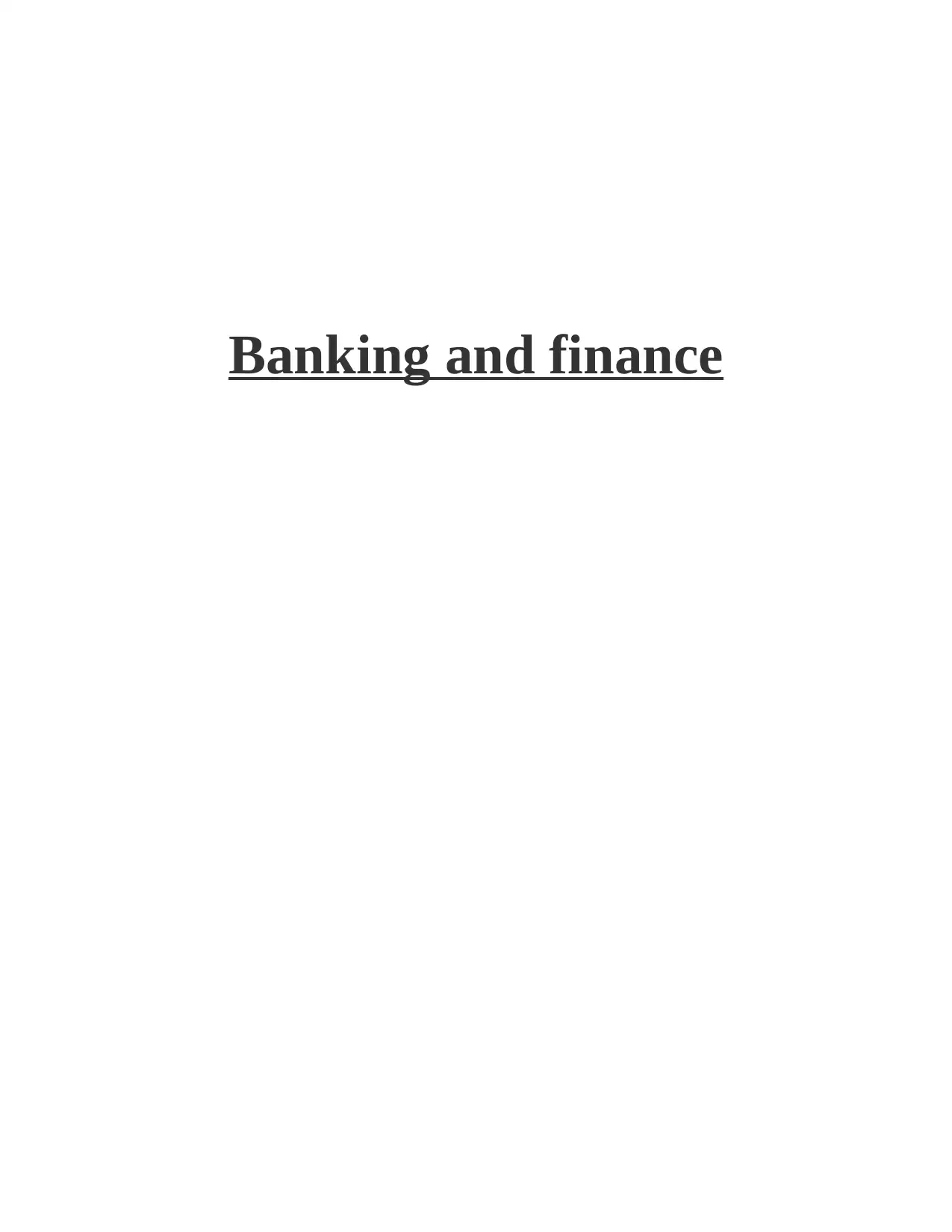
Banking and finance
Paraphrase This Document
Need a fresh take? Get an instant paraphrase of this document with our AI Paraphraser
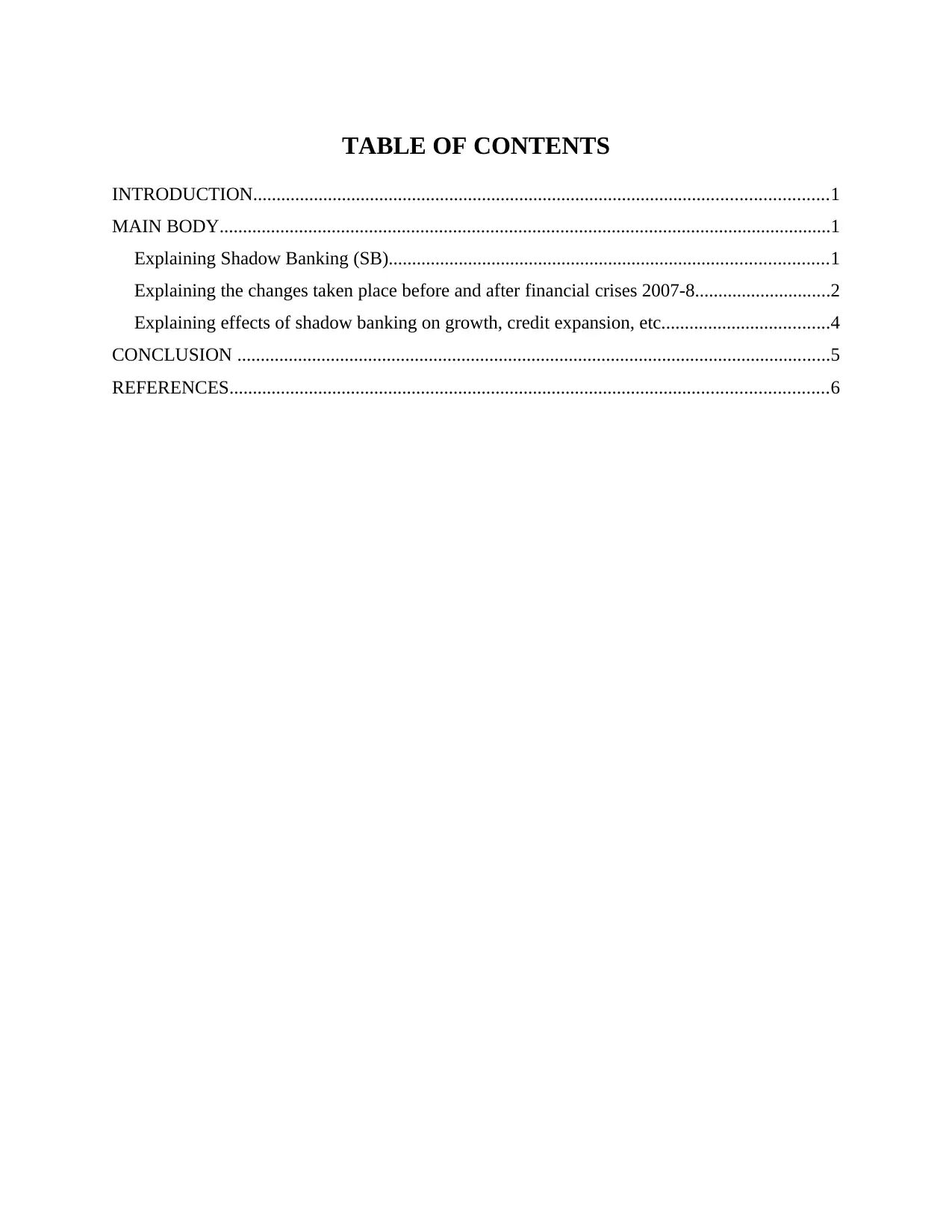
TABLE OF CONTENTS
INTRODUCTION...........................................................................................................................1
MAIN BODY...................................................................................................................................1
Explaining Shadow Banking (SB)..............................................................................................1
Explaining the changes taken place before and after financial crises 2007-8.............................2
Explaining effects of shadow banking on growth, credit expansion, etc....................................4
CONCLUSION ...............................................................................................................................5
REFERENCES................................................................................................................................6
INTRODUCTION...........................................................................................................................1
MAIN BODY...................................................................................................................................1
Explaining Shadow Banking (SB)..............................................................................................1
Explaining the changes taken place before and after financial crises 2007-8.............................2
Explaining effects of shadow banking on growth, credit expansion, etc....................................4
CONCLUSION ...............................................................................................................................5
REFERENCES................................................................................................................................6
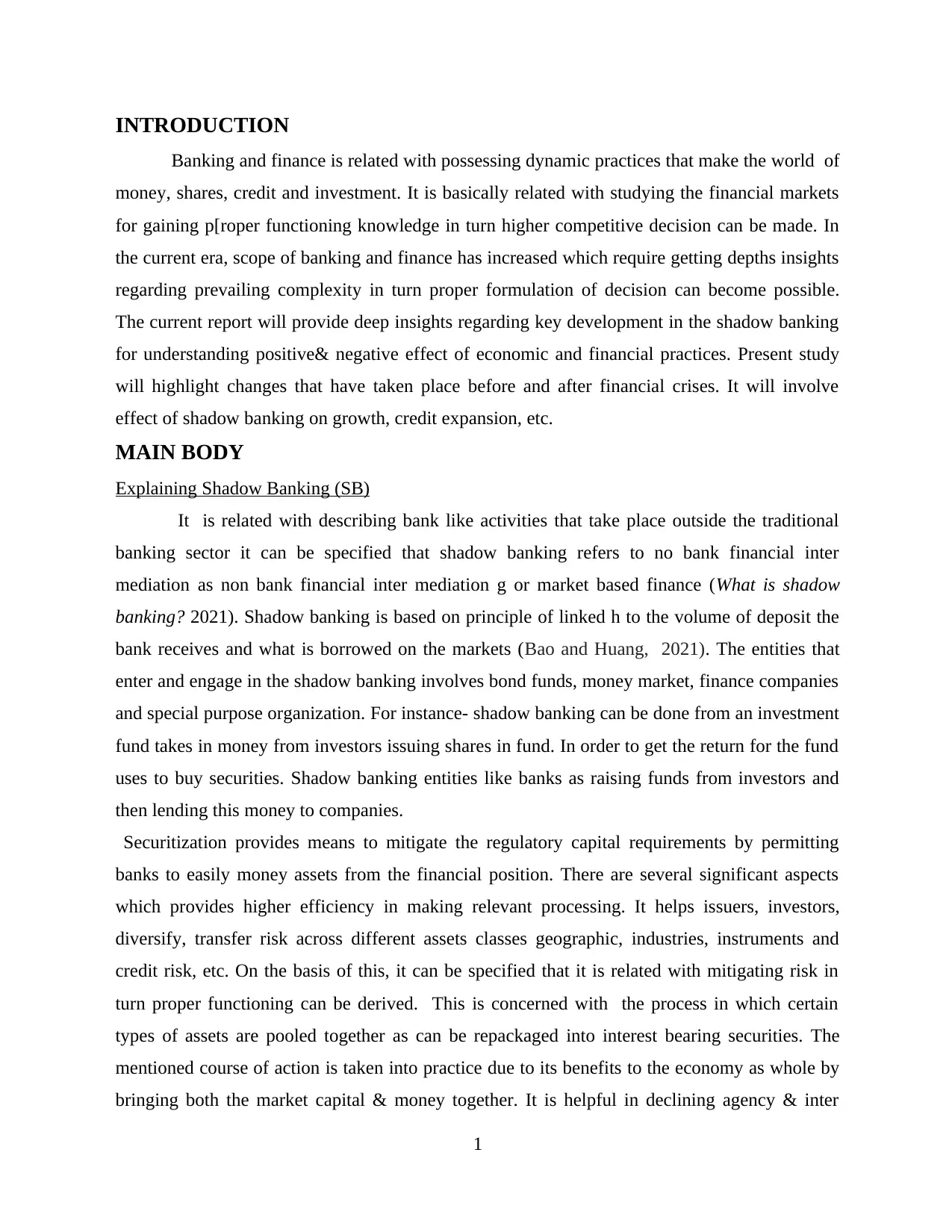
INTRODUCTION
Banking and finance is related with possessing dynamic practices that make the world of
money, shares, credit and investment. It is basically related with studying the financial markets
for gaining p[roper functioning knowledge in turn higher competitive decision can be made. In
the current era, scope of banking and finance has increased which require getting depths insights
regarding prevailing complexity in turn proper formulation of decision can become possible.
The current report will provide deep insights regarding key development in the shadow banking
for understanding positive& negative effect of economic and financial practices. Present study
will highlight changes that have taken place before and after financial crises. It will involve
effect of shadow banking on growth, credit expansion, etc.
MAIN BODY
Explaining Shadow Banking (SB)
It is related with describing bank like activities that take place outside the traditional
banking sector it can be specified that shadow banking refers to no bank financial inter
mediation as non bank financial inter mediation g or market based finance (What is shadow
banking? 2021). Shadow banking is based on principle of linked h to the volume of deposit the
bank receives and what is borrowed on the markets (Bao and Huang, 2021). The entities that
enter and engage in the shadow banking involves bond funds, money market, finance companies
and special purpose organization. For instance- shadow banking can be done from an investment
fund takes in money from investors issuing shares in fund. In order to get the return for the fund
uses to buy securities. Shadow banking entities like banks as raising funds from investors and
then lending this money to companies.
Securitization provides means to mitigate the regulatory capital requirements by permitting
banks to easily money assets from the financial position. There are several significant aspects
which provides higher efficiency in making relevant processing. It helps issuers, investors,
diversify, transfer risk across different assets classes geographic, industries, instruments and
credit risk, etc. On the basis of this, it can be specified that it is related with mitigating risk in
turn proper functioning can be derived. This is concerned with the process in which certain
types of assets are pooled together as can be repackaged into interest bearing securities. The
mentioned course of action is taken into practice due to its benefits to the economy as whole by
bringing both the market capital & money together. It is helpful in declining agency & inter
1
Banking and finance is related with possessing dynamic practices that make the world of
money, shares, credit and investment. It is basically related with studying the financial markets
for gaining p[roper functioning knowledge in turn higher competitive decision can be made. In
the current era, scope of banking and finance has increased which require getting depths insights
regarding prevailing complexity in turn proper formulation of decision can become possible.
The current report will provide deep insights regarding key development in the shadow banking
for understanding positive& negative effect of economic and financial practices. Present study
will highlight changes that have taken place before and after financial crises. It will involve
effect of shadow banking on growth, credit expansion, etc.
MAIN BODY
Explaining Shadow Banking (SB)
It is related with describing bank like activities that take place outside the traditional
banking sector it can be specified that shadow banking refers to no bank financial inter
mediation as non bank financial inter mediation g or market based finance (What is shadow
banking? 2021). Shadow banking is based on principle of linked h to the volume of deposit the
bank receives and what is borrowed on the markets (Bao and Huang, 2021). The entities that
enter and engage in the shadow banking involves bond funds, money market, finance companies
and special purpose organization. For instance- shadow banking can be done from an investment
fund takes in money from investors issuing shares in fund. In order to get the return for the fund
uses to buy securities. Shadow banking entities like banks as raising funds from investors and
then lending this money to companies.
Securitization provides means to mitigate the regulatory capital requirements by permitting
banks to easily money assets from the financial position. There are several significant aspects
which provides higher efficiency in making relevant processing. It helps issuers, investors,
diversify, transfer risk across different assets classes geographic, industries, instruments and
credit risk, etc. On the basis of this, it can be specified that it is related with mitigating risk in
turn proper functioning can be derived. This is concerned with the process in which certain
types of assets are pooled together as can be repackaged into interest bearing securities. The
mentioned course of action is taken into practice due to its benefits to the economy as whole by
bringing both the market capital & money together. It is helpful in declining agency & inter
1
⊘ This is a preview!⊘
Do you want full access?
Subscribe today to unlock all pages.

Trusted by 1+ million students worldwide
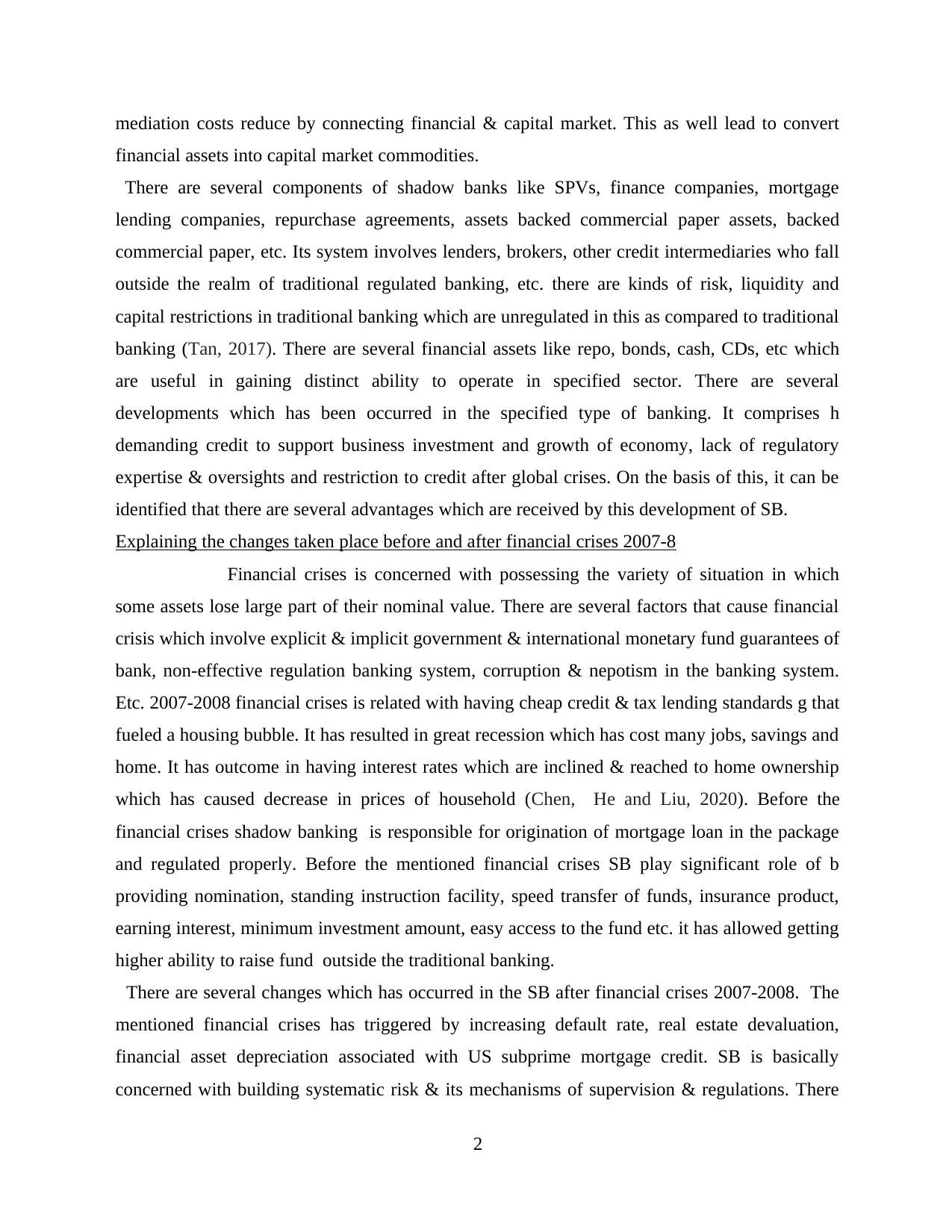
mediation costs reduce by connecting financial & capital market. This as well lead to convert
financial assets into capital market commodities.
There are several components of shadow banks like SPVs, finance companies, mortgage
lending companies, repurchase agreements, assets backed commercial paper assets, backed
commercial paper, etc. Its system involves lenders, brokers, other credit intermediaries who fall
outside the realm of traditional regulated banking, etc. there are kinds of risk, liquidity and
capital restrictions in traditional banking which are unregulated in this as compared to traditional
banking (Tan, 2017). There are several financial assets like repo, bonds, cash, CDs, etc which
are useful in gaining distinct ability to operate in specified sector. There are several
developments which has been occurred in the specified type of banking. It comprises h
demanding credit to support business investment and growth of economy, lack of regulatory
expertise & oversights and restriction to credit after global crises. On the basis of this, it can be
identified that there are several advantages which are received by this development of SB.
Explaining the changes taken place before and after financial crises 2007-8
Financial crises is concerned with possessing the variety of situation in which
some assets lose large part of their nominal value. There are several factors that cause financial
crisis which involve explicit & implicit government & international monetary fund guarantees of
bank, non-effective regulation banking system, corruption & nepotism in the banking system.
Etc. 2007-2008 financial crises is related with having cheap credit & tax lending standards g that
fueled a housing bubble. It has resulted in great recession which has cost many jobs, savings and
home. It has outcome in having interest rates which are inclined & reached to home ownership
which has caused decrease in prices of household (Chen, He and Liu, 2020). Before the
financial crises shadow banking is responsible for origination of mortgage loan in the package
and regulated properly. Before the mentioned financial crises SB play significant role of b
providing nomination, standing instruction facility, speed transfer of funds, insurance product,
earning interest, minimum investment amount, easy access to the fund etc. it has allowed getting
higher ability to raise fund outside the traditional banking.
There are several changes which has occurred in the SB after financial crises 2007-2008. The
mentioned financial crises has triggered by increasing default rate, real estate devaluation,
financial asset depreciation associated with US subprime mortgage credit. SB is basically
concerned with building systematic risk & its mechanisms of supervision & regulations. There
2
financial assets into capital market commodities.
There are several components of shadow banks like SPVs, finance companies, mortgage
lending companies, repurchase agreements, assets backed commercial paper assets, backed
commercial paper, etc. Its system involves lenders, brokers, other credit intermediaries who fall
outside the realm of traditional regulated banking, etc. there are kinds of risk, liquidity and
capital restrictions in traditional banking which are unregulated in this as compared to traditional
banking (Tan, 2017). There are several financial assets like repo, bonds, cash, CDs, etc which
are useful in gaining distinct ability to operate in specified sector. There are several
developments which has been occurred in the specified type of banking. It comprises h
demanding credit to support business investment and growth of economy, lack of regulatory
expertise & oversights and restriction to credit after global crises. On the basis of this, it can be
identified that there are several advantages which are received by this development of SB.
Explaining the changes taken place before and after financial crises 2007-8
Financial crises is concerned with possessing the variety of situation in which
some assets lose large part of their nominal value. There are several factors that cause financial
crisis which involve explicit & implicit government & international monetary fund guarantees of
bank, non-effective regulation banking system, corruption & nepotism in the banking system.
Etc. 2007-2008 financial crises is related with having cheap credit & tax lending standards g that
fueled a housing bubble. It has resulted in great recession which has cost many jobs, savings and
home. It has outcome in having interest rates which are inclined & reached to home ownership
which has caused decrease in prices of household (Chen, He and Liu, 2020). Before the
financial crises shadow banking is responsible for origination of mortgage loan in the package
and regulated properly. Before the mentioned financial crises SB play significant role of b
providing nomination, standing instruction facility, speed transfer of funds, insurance product,
earning interest, minimum investment amount, easy access to the fund etc. it has allowed getting
higher ability to raise fund outside the traditional banking.
There are several changes which has occurred in the SB after financial crises 2007-2008. The
mentioned financial crises has triggered by increasing default rate, real estate devaluation,
financial asset depreciation associated with US subprime mortgage credit. SB is basically
concerned with building systematic risk & its mechanisms of supervision & regulations. There
2
Paraphrase This Document
Need a fresh take? Get an instant paraphrase of this document with our AI Paraphraser
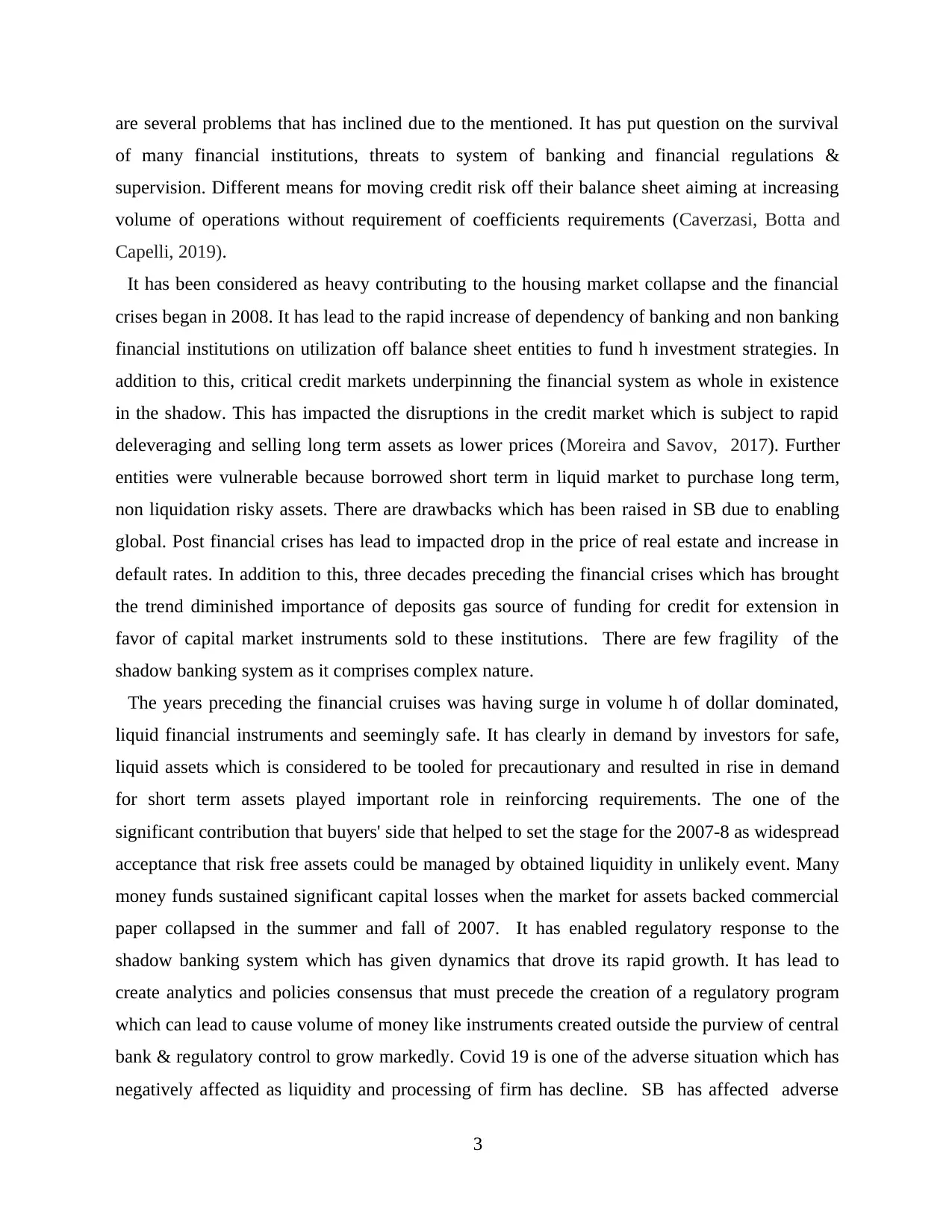
are several problems that has inclined due to the mentioned. It has put question on the survival
of many financial institutions, threats to system of banking and financial regulations &
supervision. Different means for moving credit risk off their balance sheet aiming at increasing
volume of operations without requirement of coefficients requirements (Caverzasi, Botta and
Capelli, 2019).
It has been considered as heavy contributing to the housing market collapse and the financial
crises began in 2008. It has lead to the rapid increase of dependency of banking and non banking
financial institutions on utilization off balance sheet entities to fund h investment strategies. In
addition to this, critical credit markets underpinning the financial system as whole in existence
in the shadow. This has impacted the disruptions in the credit market which is subject to rapid
deleveraging and selling long term assets as lower prices (Moreira and Savov, 2017). Further
entities were vulnerable because borrowed short term in liquid market to purchase long term,
non liquidation risky assets. There are drawbacks which has been raised in SB due to enabling
global. Post financial crises has lead to impacted drop in the price of real estate and increase in
default rates. In addition to this, three decades preceding the financial crises which has brought
the trend diminished importance of deposits gas source of funding for credit for extension in
favor of capital market instruments sold to these institutions. There are few fragility of the
shadow banking system as it comprises complex nature.
The years preceding the financial cruises was having surge in volume h of dollar dominated,
liquid financial instruments and seemingly safe. It has clearly in demand by investors for safe,
liquid assets which is considered to be tooled for precautionary and resulted in rise in demand
for short term assets played important role in reinforcing requirements. The one of the
significant contribution that buyers' side that helped to set the stage for the 2007-8 as widespread
acceptance that risk free assets could be managed by obtained liquidity in unlikely event. Many
money funds sustained significant capital losses when the market for assets backed commercial
paper collapsed in the summer and fall of 2007. It has enabled regulatory response to the
shadow banking system which has given dynamics that drove its rapid growth. It has lead to
create analytics and policies consensus that must precede the creation of a regulatory program
which can lead to cause volume of money like instruments created outside the purview of central
bank & regulatory control to grow markedly. Covid 19 is one of the adverse situation which has
negatively affected as liquidity and processing of firm has decline. SB has affected adverse
3
of many financial institutions, threats to system of banking and financial regulations &
supervision. Different means for moving credit risk off their balance sheet aiming at increasing
volume of operations without requirement of coefficients requirements (Caverzasi, Botta and
Capelli, 2019).
It has been considered as heavy contributing to the housing market collapse and the financial
crises began in 2008. It has lead to the rapid increase of dependency of banking and non banking
financial institutions on utilization off balance sheet entities to fund h investment strategies. In
addition to this, critical credit markets underpinning the financial system as whole in existence
in the shadow. This has impacted the disruptions in the credit market which is subject to rapid
deleveraging and selling long term assets as lower prices (Moreira and Savov, 2017). Further
entities were vulnerable because borrowed short term in liquid market to purchase long term,
non liquidation risky assets. There are drawbacks which has been raised in SB due to enabling
global. Post financial crises has lead to impacted drop in the price of real estate and increase in
default rates. In addition to this, three decades preceding the financial crises which has brought
the trend diminished importance of deposits gas source of funding for credit for extension in
favor of capital market instruments sold to these institutions. There are few fragility of the
shadow banking system as it comprises complex nature.
The years preceding the financial cruises was having surge in volume h of dollar dominated,
liquid financial instruments and seemingly safe. It has clearly in demand by investors for safe,
liquid assets which is considered to be tooled for precautionary and resulted in rise in demand
for short term assets played important role in reinforcing requirements. The one of the
significant contribution that buyers' side that helped to set the stage for the 2007-8 as widespread
acceptance that risk free assets could be managed by obtained liquidity in unlikely event. Many
money funds sustained significant capital losses when the market for assets backed commercial
paper collapsed in the summer and fall of 2007. It has enabled regulatory response to the
shadow banking system which has given dynamics that drove its rapid growth. It has lead to
create analytics and policies consensus that must precede the creation of a regulatory program
which can lead to cause volume of money like instruments created outside the purview of central
bank & regulatory control to grow markedly. Covid 19 is one of the adverse situation which has
negatively affected as liquidity and processing of firm has decline. SB has affected adverse
3
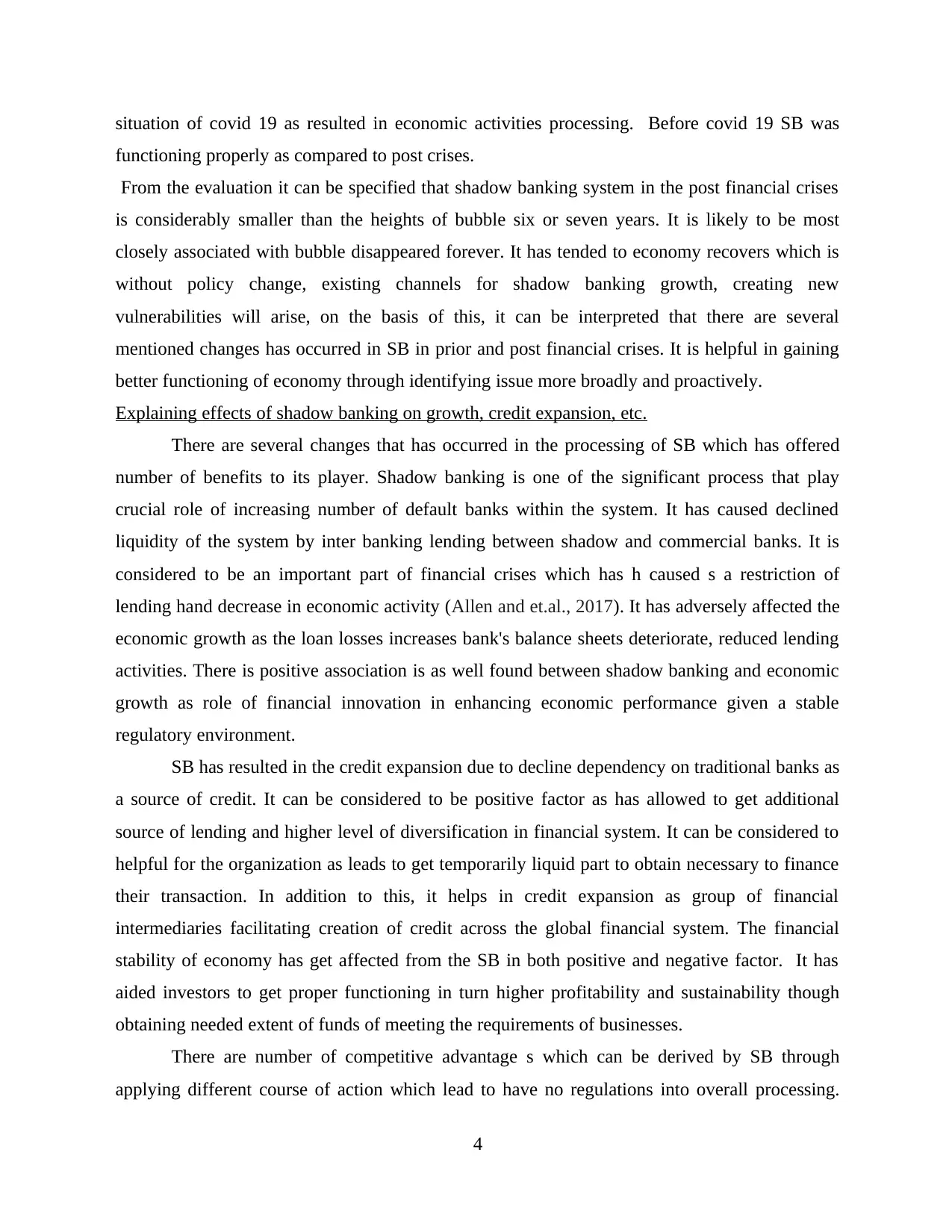
situation of covid 19 as resulted in economic activities processing. Before covid 19 SB was
functioning properly as compared to post crises.
From the evaluation it can be specified that shadow banking system in the post financial crises
is considerably smaller than the heights of bubble six or seven years. It is likely to be most
closely associated with bubble disappeared forever. It has tended to economy recovers which is
without policy change, existing channels for shadow banking growth, creating new
vulnerabilities will arise, on the basis of this, it can be interpreted that there are several
mentioned changes has occurred in SB in prior and post financial crises. It is helpful in gaining
better functioning of economy through identifying issue more broadly and proactively.
Explaining effects of shadow banking on growth, credit expansion, etc.
There are several changes that has occurred in the processing of SB which has offered
number of benefits to its player. Shadow banking is one of the significant process that play
crucial role of increasing number of default banks within the system. It has caused declined
liquidity of the system by inter banking lending between shadow and commercial banks. It is
considered to be an important part of financial crises which has h caused s a restriction of
lending hand decrease in economic activity (Allen and et.al., 2017). It has adversely affected the
economic growth as the loan losses increases bank's balance sheets deteriorate, reduced lending
activities. There is positive association is as well found between shadow banking and economic
growth as role of financial innovation in enhancing economic performance given a stable
regulatory environment.
SB has resulted in the credit expansion due to decline dependency on traditional banks as
a source of credit. It can be considered to be positive factor as has allowed to get additional
source of lending and higher level of diversification in financial system. It can be considered to
helpful for the organization as leads to get temporarily liquid part to obtain necessary to finance
their transaction. In addition to this, it helps in credit expansion as group of financial
intermediaries facilitating creation of credit across the global financial system. The financial
stability of economy has get affected from the SB in both positive and negative factor. It has
aided investors to get proper functioning in turn higher profitability and sustainability though
obtaining needed extent of funds of meeting the requirements of businesses.
There are number of competitive advantage s which can be derived by SB through
applying different course of action which lead to have no regulations into overall processing.
4
functioning properly as compared to post crises.
From the evaluation it can be specified that shadow banking system in the post financial crises
is considerably smaller than the heights of bubble six or seven years. It is likely to be most
closely associated with bubble disappeared forever. It has tended to economy recovers which is
without policy change, existing channels for shadow banking growth, creating new
vulnerabilities will arise, on the basis of this, it can be interpreted that there are several
mentioned changes has occurred in SB in prior and post financial crises. It is helpful in gaining
better functioning of economy through identifying issue more broadly and proactively.
Explaining effects of shadow banking on growth, credit expansion, etc.
There are several changes that has occurred in the processing of SB which has offered
number of benefits to its player. Shadow banking is one of the significant process that play
crucial role of increasing number of default banks within the system. It has caused declined
liquidity of the system by inter banking lending between shadow and commercial banks. It is
considered to be an important part of financial crises which has h caused s a restriction of
lending hand decrease in economic activity (Allen and et.al., 2017). It has adversely affected the
economic growth as the loan losses increases bank's balance sheets deteriorate, reduced lending
activities. There is positive association is as well found between shadow banking and economic
growth as role of financial innovation in enhancing economic performance given a stable
regulatory environment.
SB has resulted in the credit expansion due to decline dependency on traditional banks as
a source of credit. It can be considered to be positive factor as has allowed to get additional
source of lending and higher level of diversification in financial system. It can be considered to
helpful for the organization as leads to get temporarily liquid part to obtain necessary to finance
their transaction. In addition to this, it helps in credit expansion as group of financial
intermediaries facilitating creation of credit across the global financial system. The financial
stability of economy has get affected from the SB in both positive and negative factor. It has
aided investors to get proper functioning in turn higher profitability and sustainability though
obtaining needed extent of funds of meeting the requirements of businesses.
There are number of competitive advantage s which can be derived by SB through
applying different course of action which lead to have no regulations into overall processing.
4
⊘ This is a preview!⊘
Do you want full access?
Subscribe today to unlock all pages.

Trusted by 1+ million students worldwide
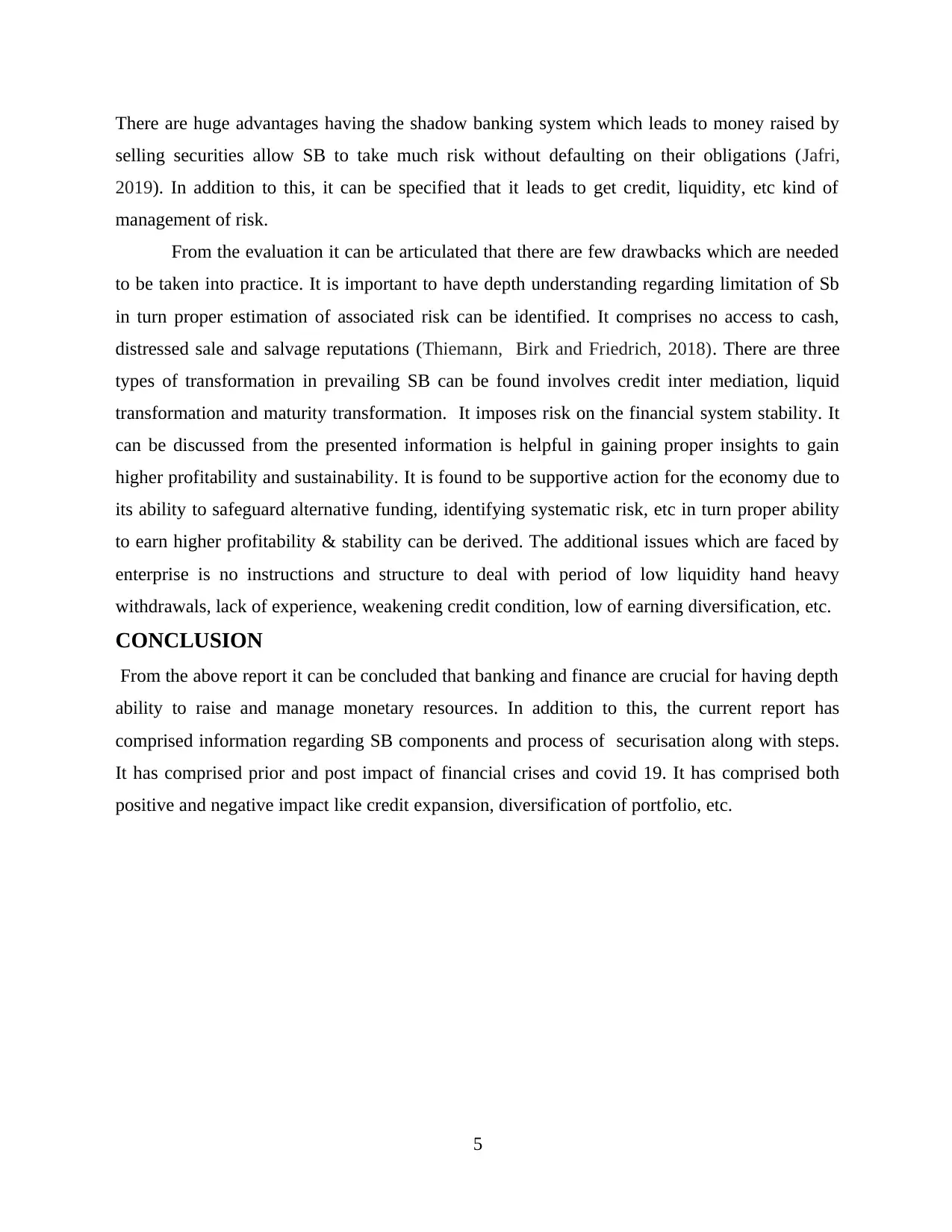
There are huge advantages having the shadow banking system which leads to money raised by
selling securities allow SB to take much risk without defaulting on their obligations (Jafri,
2019). In addition to this, it can be specified that it leads to get credit, liquidity, etc kind of
management of risk.
From the evaluation it can be articulated that there are few drawbacks which are needed
to be taken into practice. It is important to have depth understanding regarding limitation of Sb
in turn proper estimation of associated risk can be identified. It comprises no access to cash,
distressed sale and salvage reputations (Thiemann, Birk and Friedrich, 2018). There are three
types of transformation in prevailing SB can be found involves credit inter mediation, liquid
transformation and maturity transformation. It imposes risk on the financial system stability. It
can be discussed from the presented information is helpful in gaining proper insights to gain
higher profitability and sustainability. It is found to be supportive action for the economy due to
its ability to safeguard alternative funding, identifying systematic risk, etc in turn proper ability
to earn higher profitability & stability can be derived. The additional issues which are faced by
enterprise is no instructions and structure to deal with period of low liquidity hand heavy
withdrawals, lack of experience, weakening credit condition, low of earning diversification, etc.
CONCLUSION
From the above report it can be concluded that banking and finance are crucial for having depth
ability to raise and manage monetary resources. In addition to this, the current report has
comprised information regarding SB components and process of securisation along with steps.
It has comprised prior and post impact of financial crises and covid 19. It has comprised both
positive and negative impact like credit expansion, diversification of portfolio, etc.
5
selling securities allow SB to take much risk without defaulting on their obligations (Jafri,
2019). In addition to this, it can be specified that it leads to get credit, liquidity, etc kind of
management of risk.
From the evaluation it can be articulated that there are few drawbacks which are needed
to be taken into practice. It is important to have depth understanding regarding limitation of Sb
in turn proper estimation of associated risk can be identified. It comprises no access to cash,
distressed sale and salvage reputations (Thiemann, Birk and Friedrich, 2018). There are three
types of transformation in prevailing SB can be found involves credit inter mediation, liquid
transformation and maturity transformation. It imposes risk on the financial system stability. It
can be discussed from the presented information is helpful in gaining proper insights to gain
higher profitability and sustainability. It is found to be supportive action for the economy due to
its ability to safeguard alternative funding, identifying systematic risk, etc in turn proper ability
to earn higher profitability & stability can be derived. The additional issues which are faced by
enterprise is no instructions and structure to deal with period of low liquidity hand heavy
withdrawals, lack of experience, weakening credit condition, low of earning diversification, etc.
CONCLUSION
From the above report it can be concluded that banking and finance are crucial for having depth
ability to raise and manage monetary resources. In addition to this, the current report has
comprised information regarding SB components and process of securisation along with steps.
It has comprised prior and post impact of financial crises and covid 19. It has comprised both
positive and negative impact like credit expansion, diversification of portfolio, etc.
5
Paraphrase This Document
Need a fresh take? Get an instant paraphrase of this document with our AI Paraphraser
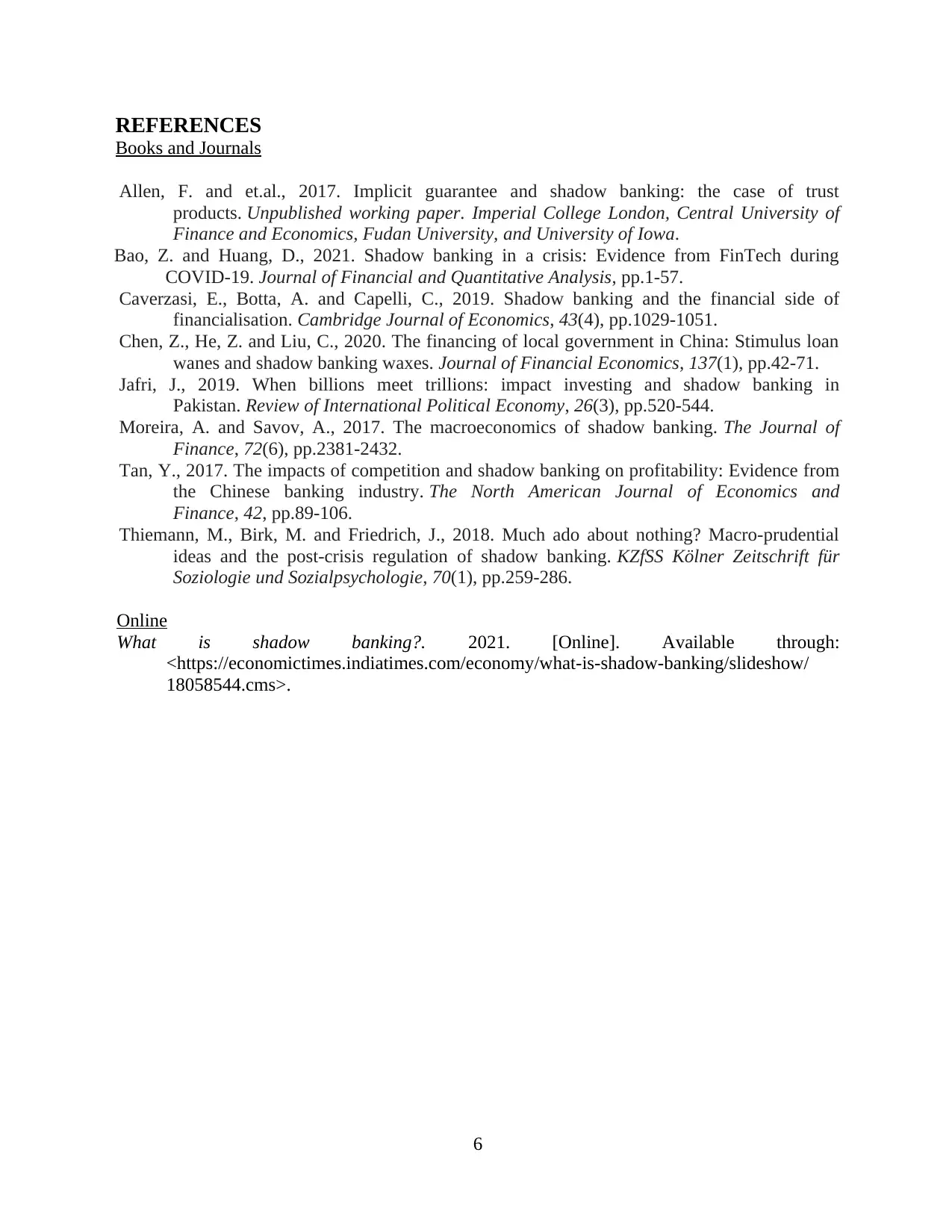
REFERENCES
Books and Journals
Allen, F. and et.al., 2017. Implicit guarantee and shadow banking: the case of trust
products. Unpublished working paper. Imperial College London, Central University of
Finance and Economics, Fudan University, and University of Iowa.
Bao, Z. and Huang, D., 2021. Shadow banking in a crisis: Evidence from FinTech during
COVID-19. Journal of Financial and Quantitative Analysis, pp.1-57.
Caverzasi, E., Botta, A. and Capelli, C., 2019. Shadow banking and the financial side of
financialisation. Cambridge Journal of Economics, 43(4), pp.1029-1051.
Chen, Z., He, Z. and Liu, C., 2020. The financing of local government in China: Stimulus loan
wanes and shadow banking waxes. Journal of Financial Economics, 137(1), pp.42-71.
Jafri, J., 2019. When billions meet trillions: impact investing and shadow banking in
Pakistan. Review of International Political Economy, 26(3), pp.520-544.
Moreira, A. and Savov, A., 2017. The macroeconomics of shadow banking. The Journal of
Finance, 72(6), pp.2381-2432.
Tan, Y., 2017. The impacts of competition and shadow banking on profitability: Evidence from
the Chinese banking industry. The North American Journal of Economics and
Finance, 42, pp.89-106.
Thiemann, M., Birk, M. and Friedrich, J., 2018. Much ado about nothing? Macro-prudential
ideas and the post-crisis regulation of shadow banking. KZfSS Kölner Zeitschrift für
Soziologie und Sozialpsychologie, 70(1), pp.259-286.
Online
What is shadow banking?. 2021. [Online]. Available through:
<https://economictimes.indiatimes.com/economy/what-is-shadow-banking/slideshow/
18058544.cms>.
6
Books and Journals
Allen, F. and et.al., 2017. Implicit guarantee and shadow banking: the case of trust
products. Unpublished working paper. Imperial College London, Central University of
Finance and Economics, Fudan University, and University of Iowa.
Bao, Z. and Huang, D., 2021. Shadow banking in a crisis: Evidence from FinTech during
COVID-19. Journal of Financial and Quantitative Analysis, pp.1-57.
Caverzasi, E., Botta, A. and Capelli, C., 2019. Shadow banking and the financial side of
financialisation. Cambridge Journal of Economics, 43(4), pp.1029-1051.
Chen, Z., He, Z. and Liu, C., 2020. The financing of local government in China: Stimulus loan
wanes and shadow banking waxes. Journal of Financial Economics, 137(1), pp.42-71.
Jafri, J., 2019. When billions meet trillions: impact investing and shadow banking in
Pakistan. Review of International Political Economy, 26(3), pp.520-544.
Moreira, A. and Savov, A., 2017. The macroeconomics of shadow banking. The Journal of
Finance, 72(6), pp.2381-2432.
Tan, Y., 2017. The impacts of competition and shadow banking on profitability: Evidence from
the Chinese banking industry. The North American Journal of Economics and
Finance, 42, pp.89-106.
Thiemann, M., Birk, M. and Friedrich, J., 2018. Much ado about nothing? Macro-prudential
ideas and the post-crisis regulation of shadow banking. KZfSS Kölner Zeitschrift für
Soziologie und Sozialpsychologie, 70(1), pp.259-286.
Online
What is shadow banking?. 2021. [Online]. Available through:
<https://economictimes.indiatimes.com/economy/what-is-shadow-banking/slideshow/
18058544.cms>.
6
1 out of 8
Related Documents
Your All-in-One AI-Powered Toolkit for Academic Success.
+13062052269
info@desklib.com
Available 24*7 on WhatsApp / Email
![[object Object]](/_next/static/media/star-bottom.7253800d.svg)
Unlock your academic potential
Copyright © 2020–2025 A2Z Services. All Rights Reserved. Developed and managed by ZUCOL.





